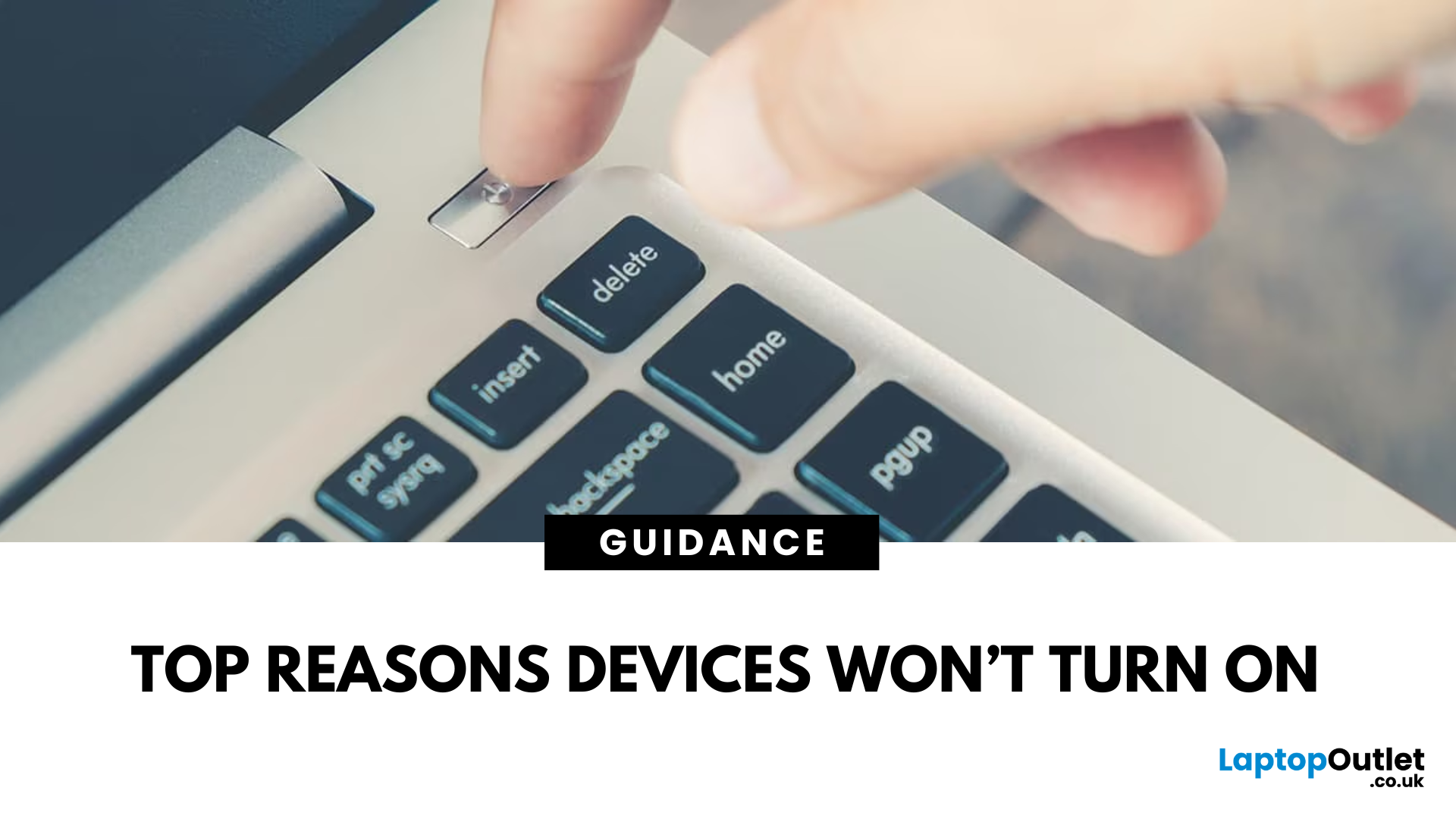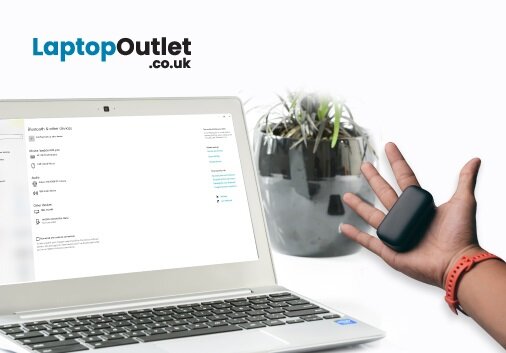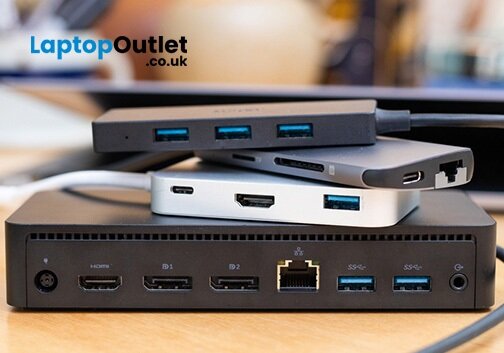7 Common Reasons Your Device Won’t Power On

Few things are more frustrating than pressing the power button and getting nothing. Whether it’s a laptop, tablet, or smartphone, devices sometimes refuse to start up. Most of the time, the cause is simple and fixable. Here are 7 common reasons your device won’t power on and what you can do about it.
1. Dead or Faulty Battery
The most common culprit is a drained or faulty battery. Lithium-ion batteries degrade over time. After ~500 charge cycles, capacity drops, and a failed battery can interrupt the DC power rail, preventing startup. If your device shows no lights or signs of life, plug it into a reliable charger and wait 10–15 minutes. If nothing changes, the battery may need replacing.
2. Faulty Charger or Cable
A damaged charger can fail to deliver proper voltage or amperage. A frayed cable or faulty adapter can stop your device from receiving power. Test with another compatible charger before assuming the problem is internal.
3. Damaged Power Button
The power button triggers the Power Management Integrated Circuit (PMIC) or Embedded Controller (EC). If the power button itself is stuck or broken, your device won’t boot. Inspect for physical damage on laptops, this can sometimes be repaired with a simple replacement switch. In addition, Some BIOS allow “power on by AC”, so try booting with lid open and charger plugged in to bypass faulty switches.
4. Overheating Protection
Many devices shut down automatically if they overheat. Modern CPUs/GPUs have thermal trip points. If temperature exceeds 100°C, the firmware enforces shutdown and may block boot until cooled. If your laptop or phone feels hot, let it cool for 20–30 minutes, then try again.
5. Corrupted Software or OS Crash
Sometimes the hardware is fine, but the operating system has frozen. On laptops, try a hard reset (holding the power button for 10+ seconds). On Chromebooks or tablets, follow reset shortcuts Esc+Refresh+Power. For smartphones, boot into recovery mode and attempt a factory reset or firmware flash.
6. Internal Hardware Failure
Loose RAM failed hard drives, or motherboard issues can all prevent startup. If your device shows flashing lights or beep codes, you can remove or reseat RAM/SSD; disconnect peripherals to isolate faulty part. If the problem persists, you need to seek professional repair.
7. Peripheral Conflicts
External devices like USB drives or docks can sometimes block booting. Disconnect all accessories and try powering on again. If device boots without peripherals, test accessories one by one to isolate the issue.
Pros & Cons of Troubleshooting at Home
Following are some pros and cons of troubleshooting that can occur at home:
|
Pros |
Cons |
|
Saves money if it’s a simple fix |
Risk of misdiagnosing the real issue |
|
Quick solutions like charger swap |
Hardware faults may need experts |
|
Learn basic maintenance skills |
DIY fixes can void warranty |
Which Fix Should You Try First?
Start with the simple checks' charger, battery, overheating. If those don’t work, try resets and remove accessories. Still no luck? Then it’s time for professional repair or a replacement device. Furthermore, if your device won’t power on even after trying these fixes, it may be time to upgrade. Shop now for a new laptop or Chromebook from Laptop Outlet and get back online without the hassle.
FAQs
What should I do first if my device won’t power on?
Start with the basics: plug it into a charger, wait a few minutes, and check for lights.
Can a dead battery stop my laptop from turning on even when plugged in?
Yes. If the battery is faulty, it can prevent power from passing through. Try removing the battery (if possible) and running on AC power alone.
How do I know if the problem is hardware or software?
If your device shows lights or makes sounds but doesn’t boot, it’s often software. If it shows nothing at all, it may be hardware.
Is it worth repairing a device that won’t turn on?
If it’s under warranty, yes. For older devices, replacement may be the more cost-effective option.
Can overheating cause a device to stop turning on?
Yes, many devices have thermal protection that prevents startup until cooled.
Summary
If your device won’t power on, it could be due to a dead battery, faulty charger, damaged power button, overheating, corrupted software, or internal hardware failure. Start by checking the charger and battery, then move on to resets and professional repair if needed.
| Read More: |
| Thin and Light Windows 10 Laptops: Balancing Portability and Performance |
| Which Brand is Best for Windows Laptops? Hardware Support |
| Which is the Best Laptop for Windows Pro? |
Related Articles

December 30, 2021

February 23, 2022

December 13, 2023
Introduction
The joy of having your first pair of Bluetooth earbuds is still memorable for many people. They are extremely convenient, but the story of pairing earbuds with a laptop is completely different than pairing them with mobile phones. Connecting earbuds to a laptop is not always as straightforward as it may seem, especially for those who have never connected earbuds to a laptop.
In today's fast-paced world, where technology is at the forefront of our daily lives, seamless connectivity has become more crucial. Laptops, serving as indispensable tools, are often accompanied by the desire for high-quality audio experiences. This has led to the increasing popularity of earbuds due to their convenience and portability. The process can be complex with various devices and operating systems. This comprehensive guide aims to walk you through the step-by-step process of connecting your earbuds to a laptop, covering different scenarios, troubleshooting tips, and insights into optimising

January 15, 2024
Introduction
Are you frustrated with wires scattered across your desktop and need a simple fix to keep your gadgets charged and organised?
In the world of desktop technology, the USB-C port has emerged as a versatile force with streamlined connectivity and enhanced functionality. As desktop setups become sophisticated, the demand for efficient cable management and expanded connectivity has grown.
Desktop docking stations can enhance productivity, improve ergonomics and ensure convenience for content creation, 3D designers, and CAD engineers. They allow connections between the monitor, keyboard, mouse, storage drive, network port, headphone jack, SD card, and charging ports.
This comprehensive guide explores USB-C docks and their compatibility with various desktop systems. You will learn everything from understanding the fundamentals of USB-C technology to choosing the right dock for your specific desktop needs.
So, let's get into it!
Standard Ports Available in USB-C Docks
USB-C docks are
